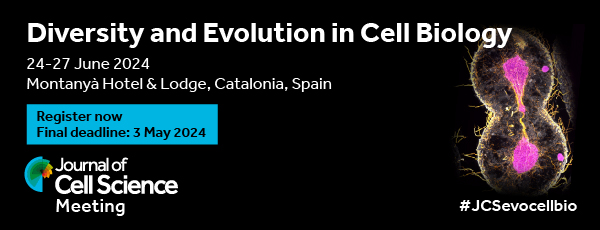Issues
-
Cover image
Cover Image

Cover: Spinning-disk microscopy image of Nup133Δmid mouse embryonic stem cells at day 7 of differentiation towards neuroectoderm. Cells show a typical rosette organisation, with neuronal progenitors (labelled by Pax6, purple) at the centre and differentiated neurons (labelled with HuC/D, blue) at the periphery. The nuclear pores, labelled by GFP–Nup133Δmid (orange), form a discontinuous rim at the nuclear envelope. See article by C. Orniacki et al. (jcs261151).
- PDF Icon PDF LinkTable of contents
- PDF Icon PDF LinkIssue info
RESEARCH HIGHLIGHTS
CELL SCIENTISTS TO WATCH
REVIEWS
Gluing yeast peroxisomes – composition and function of membrane contact sites
Summary: Peroxisomes form membrane contact sites with many other cell organelles. In this Review, an overview is given of the current knowledge on peroxisomal membrane contact sites in yeast.
Mitophagy and long-term neuronal homeostasis
Summary: Mitophagy contributes to the maintenance of nervous system homeostasis. Defective or dysregulated mitophagy has been implicated in the pathogenesis of neurodegenerative diseases.
SHORT REPORT
Nuclear segmentation facilitates neutrophil migration
Highlighted Article: Using heterogenous neutrophils mobilized following endotoxin administration in humans, we show that neutrophils with nuclei segmented into more lobes can migrate faster in a physically confined space.
RESEARCH ARTICLES
Cik1 and Vik1 accessory proteins confer distinct functions to the kinesin-14 Kar3
Summary: We show, through biochemical reconstitution experiments and live-cell imaging, that functions and localization of Kar3 are dictated by the stage of the cell cycle and the activities of two Kar3 accessory binding partners – Cik1 and Vik1.
Y-complex nucleoporins independently contribute to nuclear pore assembly and gene regulation in neuronal progenitors
Highlighted Article: The Y-complex nucleoporins Nup133 and Seh1 have roles in gene regulation upon neuroectodermal differentiation, and this process can be uncoupled from nuclear pore basket integrity.
A human septin octamer complex sensitive to membrane curvature drives membrane deformation with a specific mesh-like organization
Highlighted Article: The human octameric septin complex forms a two-layered mesh of orthogonal filaments on the membrane, which is sensitive to micrometric membrane curvature and drives membrane reshaping.
The histone methyltransferase NSD3 contributes to sister chromatid cohesion and to cohesin loading at mitotic exit
Summary: NSD3-dependent methylation contributes to sister chromatid cohesion by ensuring proper kollerin recruitment and subsequent cohesin loading during mitotic exit.
The human discs large protein 1 interacts with and maintains connexin 43 at the plasma membrane in keratinocytes
Summary: Discs large protein 1 (Dlg1) interacts with the gap junction protein connexin 43 (Cx43) in keratinocytes. Dlg1 depletion leads to low Cx43 levels and reduced intercellular communication. Dlg1 might maintain Cx43 at the plasma membrane.
Altered cohesin dynamics and H3K9 modifications contribute to mitotic defects in the cbf11Δ lipid metabolism mutant
Summary: Lack of the Cbf11 transcription factor in S. pombe disrupts lipid metabolism, leading to mitotic defects involving aberrant cohesin dynamics and chromatin structure.
Oxidative stress induces chromosomal instability through replication stress in fibroblasts from aged mice
Summary: Fibroblasts from aged mice show chromosomal instability. Oxidative stress causes replication stress, which promotes chromosomal instability.
Radial spoke protein 9 is necessary for axoneme assembly in Plasmodium but not in trypanosomatid parasites
Summary: Radial spoke head protein 9 (RSP9) is found in the flagella of trypanosomatids and malaria parasites, and is important for motility in trypanosomatids but critical for fertilisation in Plasmodium.
A genome-wide genetic screen identifies CYRI-B as a negative regulator of CEACAM3-mediated phagocytosis
Summary: CYRI-B limits CEACAM3-mediated phagocytosis.
TOOLS AND RESOURCES
Confinement plus myosin-II suppression maximizes heritable loss of chromosomes, as revealed by live-cell ChReporters
Summary: Chromosome losses and gains are most prominent in solid tumors. Use of novel chromosome reporters shows that confinement of normal and cancer cells drives chromosome losses, which myosin-II suppression maximizes.
FIRST PERSON
CORRECTION
Correction: BMP9-regulated angiogenic signaling plays an important role in the osteogenic differentiation of mesenchymal progenitor cells
Introducing our new Editors

We welcome three new Editors to Journal of Cell Science - Robert Parton, Richa Rikhy and Simon Cook. You can read more about them in the Editorial from our Editor-in-Chief Michael Way.
2024 Journal Meeting 'Diversity and Evolution in Cell Biology'

Registration is open for our 2024 Journal Meeting Diversity and Evolution in Cell Biology, which aims to bring together evolutionary biologists and cell biologists investigating diverse aspects of cellular physiology. Final registration deadline: 3 May 2024.
Workshop: Physics of the Early Embryonic Cell Divisions

Early-career researchers interested in the roles of nuclear lipids, apply now for one of the ten funded places at this Workshop, which will take place 11-14 November 2024. Application deadline: 17 May.
Reasons to submit to Journal of Cell Science

There are many benefits to publishing in Journal of Cell Science - read more about why you should choose JCS or visit our submission page now.
Propose a new Workshop for 2026

We are now accepting proposals for our 2026 Workshops programme. We aim to be responsive to the community and open to novel initiatives, so if you have a new idea for a biological workshop that you feel would work well, please apply. Applications deadline: 19 July 2024.



